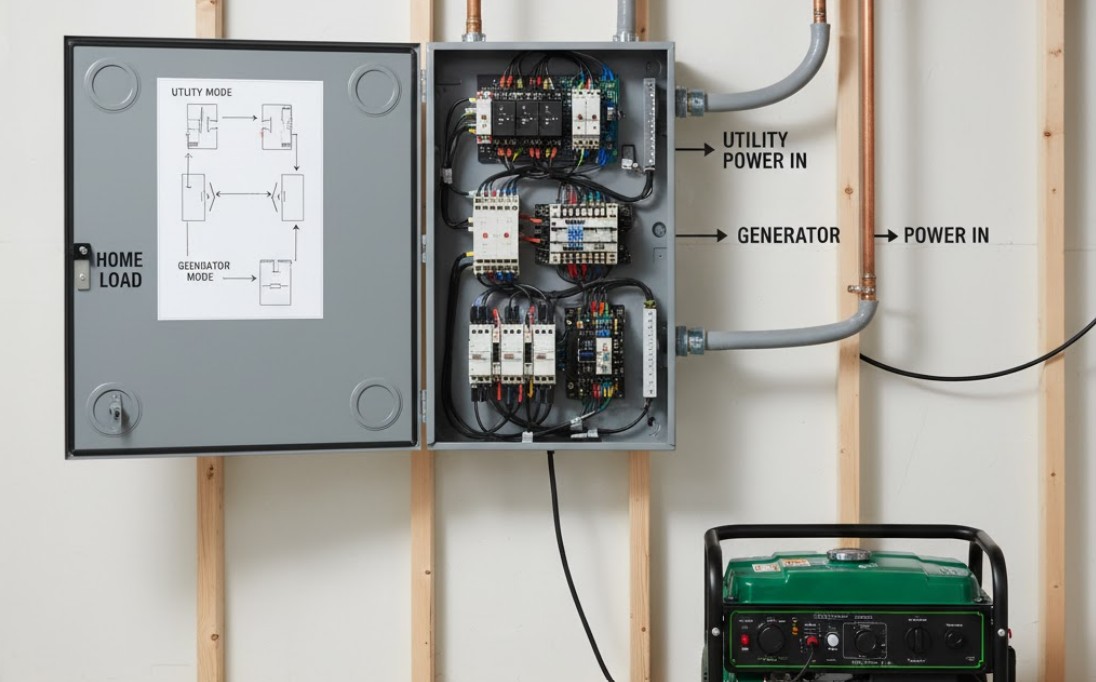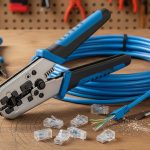When the lights go out, a generator is your family’s lifeline, providing the essential power needed to keep systems running, from refrigerators to medical equipment. However, simply plugging a generator into an outlet or directly into your home’s main electrical panel is incredibly dangerous and often illegal. This is where the **generator transfer switch** comes steps in, playing an absolutely critical, yet often misunderstood, role in home backup power systems. This comprehensive article will demystify the technology and explain in detail how does a generator transfer switch work to keep your power flowing safely and efficiently during an outage.

The Critical Role of the Generator Transfer Switch
At its core, a generator transfer switch is an electrical safety device designed to solve one primary and critical problem: preventing backfeeding. What is backfeeding? In simple terms, it’s the dangerous flow of electrical power from a generator back into the public utility’s power grid. This phenomenon poses a lethal risk to utility workers who might be repairing lines they assume are de-energized. Furthermore, it can severely damage your generator, your home’s electrical system, and the utility grid itself. Therefore, a transfer switch is mandated by the National Electrical Code (NEC) in nearly all jurisdictions when connecting a generator to a home’s wiring.
A transfer switch ensures a strict, non-negotiable physical separation between two power sources: the utility power (your standard electrical company) and your generator power. It operates on an “either-or” principle, making it impossible for both sources to be connected to your home’s electrical panel simultaneously.
For more detailed information on the dangers involved, you can consult this resource on backfeeding.
Dissecting the Mechanism: How Does a Generator Transfer Switch Work?
The operation of a transfer switch can be broken down into three main stages: Monitoring, Isolation, and Connection. While the complexity varies between manual and automatic models, the fundamental principle of source separation remains constant.
The Core Components and Connections
Regardless of type, a transfer switch has several key connection points:
- Utility Input: Connects directly to the main breaker panel, drawing power from the electrical grid.
- Generator Input: Connects to the generator, often through a power inlet box (for portable units) or directly (for standby units).
- Load Output (or Load Center Connection): Connects to the home’s main electrical panel or a sub-panel, sending power to the circuits selected to be powered by the generator (the ‘loads’).
- Switching Mechanism: This is the actual physical component—a breaker, contactor, or solenoid—that moves to select which power source is active.
Monitoring and Power Interruption
The process begins when the utility power fails. For a manual transfer switch (MTS), this monitoring is done by the homeowner. They physically notice the outage. For an automatic transfer switch (ATS), the process is sophisticated. The ATS constantly monitors the utility power through a built-in sensing circuit. When the voltage on one or more phases drops below a pre-set threshold (signaling an outage), the ATS initiates the transfer sequence. Conversely, when the voltage returns to normal and stabilizes, the ATS initiates the reverse sequence.
Isolation (The Safety Step)
Once an outage is confirmed, the transfer switch must physically disconnect the home from the utility grid. This is the crucial isolation step. The switching mechanism moves from the ‘Utility’ position to a ‘Neutral’ or ‘Off’ position, ensuring the home is momentarily completely isolated from both power sources. This is key to preventing the deadly backfeeding scenario.
Connection (Transferring the Load)
After isolation, the switch connects the home to the backup power. If it’s an ATS, it sends a start signal to the standby generator (typically after a brief delay to ensure the outage isn’t momentary). Once the generator is running and its voltage and frequency are stable (usually 5-15 seconds), the switching mechanism completes the throw, moving to the ‘Generator’ position. The generator is now safely supplying power to the home’s pre-selected circuits. This entire process, for a modern ATS, often takes less than 30 seconds from the moment the power fails.
With a manual transfer switch (MTS), the homeowner performs these actions: starting the generator, waiting for it to stabilize, and then physically moving the switch lever or flipping the master breakers on the transfer switch panel.
Types of Generator Transfer Switches Explained
While the goal is the same—safe source separation—the method of operation defines the two main categories of transfer switches.
Manual Transfer Switch (MTS)
A Manual Transfer Switch is the simpler and typically more affordable option, commonly used with portable generators. The entire transfer process requires human intervention.
How the Manual Transfer Switch Works
- Outage Occurs: Homeowner notices the power is out.
- Generator Setup: The portable generator is moved to a safe outdoor location, fueled, and started.
- Cable Connection: A heavy-duty power cord is run from the generator to a dedicated power inlet box mounted outside the home.
- Manual Transfer: The homeowner goes to the MTS panel (usually near the main electrical panel) and manually flips the main transfer switch (often a large 2-pole breaker or lever) from the ‘Utility’ position to the ‘Generator’ position. This action simultaneously disconnects the utility and connects the generator.
- Circuit Selection: Within the MTS, the homeowner can then flip individual circuit breakers (representing the selected circuits like the furnace, fridge, or lights) to draw power from the generator.
Manual systems are excellent for those using best portable home backup generators or best inverter generator for home backup, as they provide an affordable and reliable safeguard against backfeeding.
Automatic Transfer Switch (ATS)
An Automatic Transfer Switch is the standard and necessary component for standby generator systems. It operates seamlessly without any required human action.
How the Automatic Transfer Switch Works
- Utility Monitoring: The ATS constantly senses the incoming utility power.
- Outage Detection: Utility power fails, and the voltage drops below a preset minimum for a specific duration (e.g., 5 seconds).
- Generator Start-Up: The ATS controller sends a signal to the standby generator to start. The generator’s engine fires up and warms up briefly.
- Voltage Verification: Once the generator reaches the correct voltage and frequency (e.g., 120/240V, 60 Hz), the ATS is verified as stable.
- Automatic Transfer: The ATS physically moves the contactors, instantaneously disconnecting the utility lines and connecting the generator lines to the home’s electrical system.
- Power Restoration: When the utility power returns and stabilizes for a pre-determined time, the ATS initiates the cool-down sequence. It disconnects the generator and reconnects the utility. The generator is allowed to run without a load for a few minutes to cool down, then automatically shuts off.
The ATS is a key differentiator for whole house generators or home standby generators, ensuring a near-instantaneous and hands-off transition, making them popular for homeowners seeking a premium, seamless backup solution. You can find more information about these units here: best whole house generators and best home standby generators.
Transfer Switch Sizing and Installation Considerations
Choosing and installing the correct transfer switch is as important as choosing the right generator. Sizing is crucial, as the switch must be able to handle the total electrical current it will manage.
Sizing the Switch: Ampacity Matters
The size of a transfer switch is rated in amperage (Amps). For a whole-house system, the switch must match or exceed the amperage of your main service panel (e.g., 200 Amps). A load-side transfer switch is designed to power only a select number of circuits, and its size can be smaller (e.g., 30 or 50 Amps) but must be rated to handle the combined load of the circuits it controls.
Load shedding is an advanced feature often included in larger ATS units. It allows the switch to temporarily drop high-demand, non-essential loads (like air conditioning units or electric water heaters) when the generator is running to prevent overloading. This maximizes the efficiency and longevity of your backup system.
Installation Requirements and Safety
Due to the complexity and inherent danger of working with high-voltage electricity, transfer switch installation is not a DIY project. It must be performed by a licensed and qualified electrician, often requiring permits and inspections. The electrician ensures:
- The switch is properly grounded.
- Wire sizes (gauges) are correct for the current load.
- The unit is physically protected and installed according to local electrical codes.
- The backfeeding protection mechanism is functioning flawlessly.
The Transfer Switch in Modern Generator Systems
The functionality of the transfer switch is evolving, especially with the rise of alternative backup power solutions like solar and inverter technology.
Transfer Switches for Inverter Generators
Inverter generators produce a very clean, stable power sine wave, making them popular for sensitive electronics. When used for home backup, they still require a transfer switch—typically a manual one—to comply with safety codes. The core function of preventing backfeeding remains paramount, regardless of the generator’s power quality.
For more information on these clean power sources, check out best inverter generator for home backup.
Transfer Switches in Solar Generator Systems
Solar generators (large battery backup systems) often utilize an internal, sophisticated transfer mechanism or are connected via an external ATS integrated with the solar inverter. This ensures that when the grid goes down, the home is immediately disconnected from the utility, and the home’s critical loads are powered by the stored solar energy. In these hybrid systems, the switch manages the transition not just between utility and generator, but often between utility, solar, and battery storage.
Interested in harnessing the sun? Explore best solar generators for home backup.
Common Misconceptions About Transfer Switches
Despite their critical function, there are several misunderstandings about what a transfer switch does and does not do.
Misconception 1: “A Transfer Switch is the Same as a Circuit Breaker.”
While some manual transfer switches use standard circuit breakers as the switching mechanism, their function is different. A circuit breaker protects wires from overcurrent (overload or short circuit). A transfer switch transfers power between two sources and isolates one from the other. It is primarily a safety and operational device, not purely a protection device.
Misconception 2: “I Can Just Use an Extension Cord.”
Using extension cords to run individual appliances from a generator is safe, provided the cords are properly rated. However, this is not a solution for powering essential hardwired systems like a furnace, well pump, or central air conditioner. Connecting a generator to your main electrical panel without a transfer switch (known as backfeeding) is what creates the lethal danger and is illegal.
Misconception 3: “Automatic Transfer Switches are Only for Whole House Generators.”
While an ATS is standard for standby generators, it can theoretically be configured to start and manage a portable generator (provided the portable unit has an electric start and is set up for remote signaling). However, the manual steps of fueling and cable connection make this combination uncommon and less practical than simply using a manual transfer switch.
Final Thoughts
The generator transfer switch is truly the unsung hero of any reliable home backup power system. It’s the essential link that translates the power generated by your unit into safe, usable electricity within your home. Whether you opt for the hands-on control of a manual transfer switch for your portable unit or the seamless, automated convenience of an automatic transfer switch for a permanent standby system, its core function remains non-negotiable: preventing the deadly hazard of backfeeding.
Understanding how does a generator transfer switch work is not just about comprehending an electrical device; it’s about making a fully informed decision that ensures the safety of your family, the longevity of your electrical equipment, and the protection of the utility workers serving your community. Invest in the right switch, have it professionally installed, and you can rest easy knowing that when the grid fails, your transition to backup power will be safe, swift, and reliable.
Amranul is a highly experienced product review writer with a passion for helping readers make smart, informed purchasing decisions. Since 2018, he has specialized in thoroughly researching and analyzing a wide range of products to deliver honest, in-depth reviews. Amranul combines technical accuracy with clear, engaging writing to break down complex product features and highlight true user value. Look for his reviews to find reliable information and expert insights you can trust before you buy!





